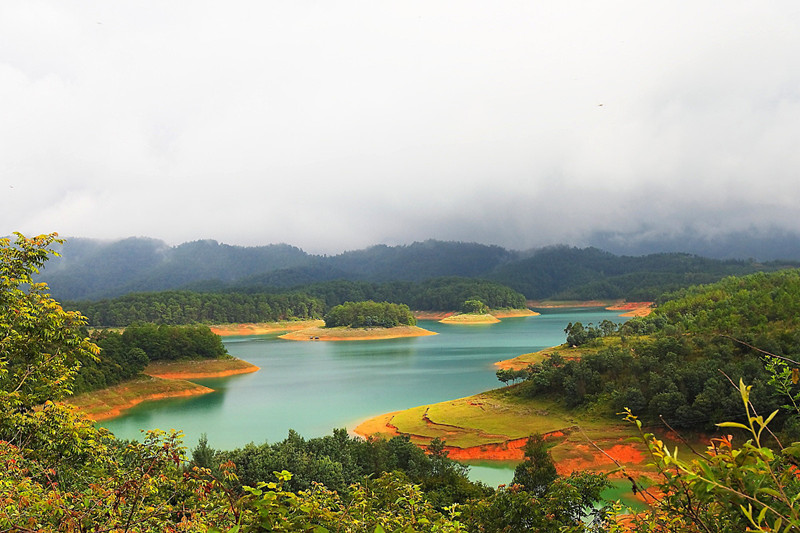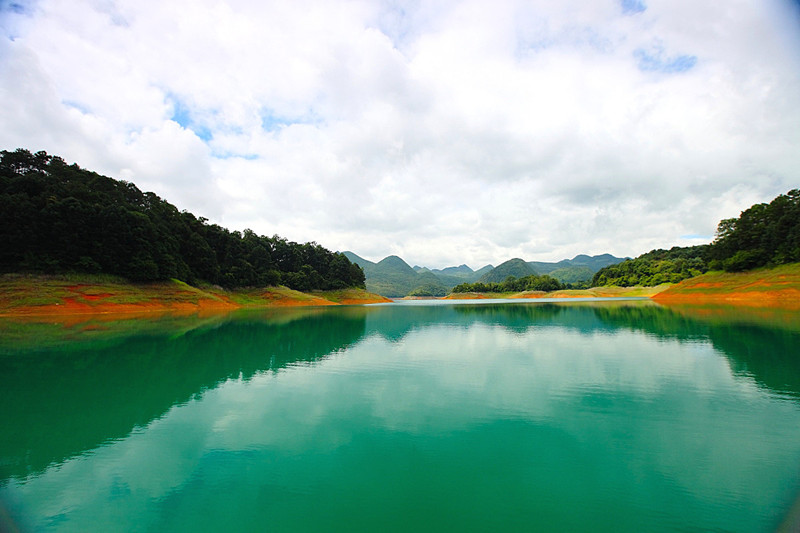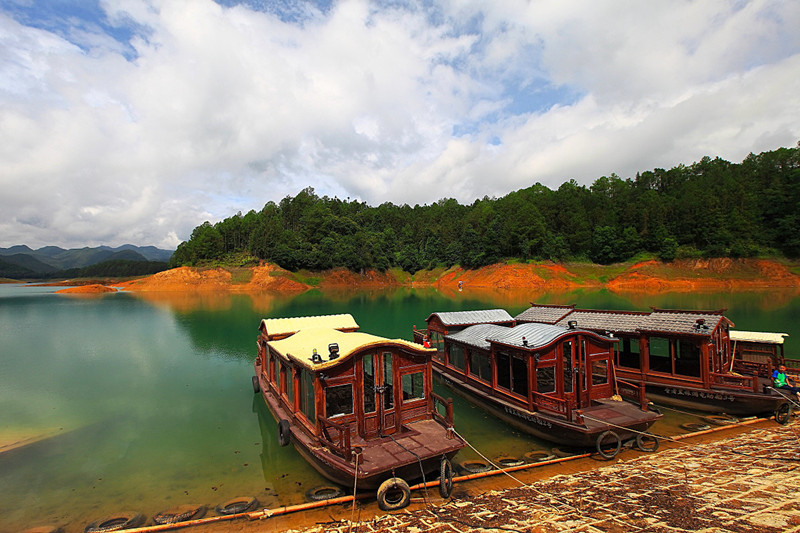
Bailonghu Lake in Qiubei County, Wenshan
Chinese Name: 丘北县摆龙湖
English Name: Bailonghu Lake in Qiubei County, Wenshan
Bailonghu Lake (壮语: Nyi Bizlangx)
Bailonghu Lake is located 26 kilometers west of Qiubei County, Wenshan Prefecture, Yunnan Province, at the southern foot of Bailuo Mountain in Yuezhai Town. The lake is a highland freshwater lake, characterized by its blue-green water with a transparency of 4-5 meters, and up to 7-8 meters under calm conditions. It has a water capacity of 53.7 million cubic meters, an average depth of 27 meters, and covers an area of 3.16 square kilometers. It is one of the top ten lakes in Yunnan.
Overview
Bailonghu Lake is one of the sources of the Qing Shui River, which eventually flows into the Pearl River. The water of Bailonghu Lake remains clear and transparent throughout the year, even during the flood season. Surrounded by mountains, with water in the mountains and a lake within the water, the lake has a fan-shaped distribution. It features seven small islands and three peninsulas, earning it the nickname “Thousand Island Lake of Yunnan.” The islands are lush with dense forests, serve as habitats for migratory birds, and offer a picturesque setting with seasonal bird songs and blooming flowers.
Development History
The lake was originally known as Hongqi Reservoir and was constructed during the era of the “Three Red Flags” — the general line, the Great Leap Forward, and the People’s Commune. The project began in November 1958 and was completed in 1976 after nearly twenty years of construction. The total investment amounted to 17.2156 million yuan, with 5.4942 million work hours contributed by the public. Thousands of workers built a wave-proof wall and a dam with a height of 30.36 meters, a base length of 58 meters, a top length of 260 meters, and a width of 196.75 meters. The water source is supplied by intercepted Bailuo Longtan water and rainfall. The reservoir’s runoff area is 120 square kilometers, with a surface runoff area of 12.6 square kilometers, a reservoir capacity of 53.7 million cubic meters, and an irrigation area of 83,600 acres.
Legend
According to legend, Bailonghu Lake was not always known by this name. Beneath the lake was a hillside with a village called Bailuo Village. The Zhang family in the village had three daughters. Due to the long-term drought and lack of water, the elder sisters married and left, while the youngest stayed behind to care for their aging parents. One day, a young man named A Long passed through Bailuo Village and met Zhang’s youngest daughter. They fell in love at first sight, and A Long decided to stay. To find water for the villagers, Zhang and A Long searched the mountains and eventually found a water-filled cave at the base of a large mountain. However, A Long accidentally fell into the cave’s water pool. Zhang cried at the cave entrance for seven days and nights, and when A Long did not return, she jumped into the cave to join him. The water from the cave then flooded the surrounding mountains and fields, creating the lake. In memory of the lovers, the lake was named Bailonghu, and the seven islands in the lake are said to represent the seven days and nights Zhang cried.
Scenic Description
Visitors to Bailonghu Lake are greeted by its sparkling, emerald waters surrounded by seven small islands. The lush vegetation around the lake and on the islands consists mainly of Yunnan pine and rhododendron. In autumn and winter, large numbers of egrets, wild ducks, and geese inhabit the islands, creating a unique sight. The lake’s stunning green scenery is captivating, providing a serene escape from the hustle and bustle of city life.
Boating on the lake offers a refreshing experience with gentle breezes and picturesque views of the surrounding mountains and blue sky. The lake is home to flashing lights in the water, where precious silver fish are said to reside. The islands and lake’s shoreline feature a variety of wildflowers and edible plants, enhancing the natural beauty.
On the islands, visitors can enjoy a range of local delicacies, such as roasted whole sheep, fresh fish, and fragrant potato rice. The lake’s infrastructure has been upgraded with standard forest guesthouses, pavilions, and picnic areas.
Local Cuisine
- Whole Lotus Feast
- Whole Lamb Banquet
- Three-Line Cured Meat
- Wild Lotus Seed Stewed Pork Knuckle
- Bahang Chicken
- Crystal Meat
- Zongba (Rice Cake)
- Flower Glutinous Rice
Local Products
- Niyi Jiao (Local Wine)
- Lotus Powder
- Qiubei Chili
- Sanqi (Chinese Ginseng)
- Cao Wu (Aconite)
- Wood Ear Mushrooms
- Bamboo Tube Tea
- Nalang Wine
- Ethnic Handicrafts






 7 Days GolfingTour
7 Days GolfingTour
 8 Days Group Tour
8 Days Group Tour
 8 Days Yunnan Tour
8 Days Yunnan Tour
 7 Days Shangri La Hiking
7 Days Shangri La Hiking
 11 Days Yunnan Tour
11 Days Yunnan Tour
 6 Days Yuanyang Terraces
6 Days Yuanyang Terraces
 11 Days Yunnan Tour
11 Days Yunnan Tour
 8 Days South Yunnan
8 Days South Yunnan
 7 Days Tea Tour
7 Days Tea Tour
 8 Days Muslim Tour
8 Days Muslim Tour
 12 Days Self-Driving
12 Days Self-Driving
 4 Days Haba Climbing
4 Days Haba Climbing
 Tiger Leaping Gorge
Tiger Leaping Gorge
 Stone Forest
Stone Forest
 Yunnan-Tibet
Yunnan-Tibet
 Hani Rice Terraces
Hani Rice Terraces
 Kunming
Kunming
 Lijiang
Lijiang
 Shangri-la
Shangri-la
 Dali
Dali
 XishuangBanna
XishuangBanna
 Honghe
Honghe
 Kunming
Kunming
 Lijiang
Lijiang
 Shangri-la
Shangri-la
 Yuanyang Rice Terraces
Yuanyang Rice Terraces
 Nujiang
Nujiang
 XishuangBanna
XishuangBanna
 Spring City Golf
Spring City Golf
 Snow Mountain Golf
Snow Mountain Golf
 Stone Mountain Golf
Stone Mountain Golf















